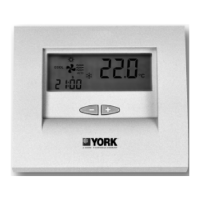
Do you have a question about the York DPC-1 and is the answer not in the manual?
| Type | Digital |
|---|---|
| Display | LCD |
| Backlit | Yes |
| Programmable | Yes |
| Power Source | Battery |
| Programmability | Yes |
| Voltage | 24V |
| Compatibility | Standard HVAC Systems |
| Battery | 2 AA |
Thermostat shown with front cover closed, in its normal position.
Thermostat with front cover open, revealing controls.
Detailed explanation of all icons and indicators displayed on the thermostat screen.
System is off; displays temperature, day, and time. Fan status is also shown if active.
Activates cooling only. Displays mode, temperature, demand icon, and status.
Activates heating only. Displays mode, temperature, demand icon, and status.
Activates heating and cooling. Displays mode, temperature, demand, and status.
Combines AUTO mode with time schedule profile. 'PROG' indicator is shown.
Special heating mode for auxiliary heat sources, avoiding compressor use.
Only fan operates; AC system is off. Displays 'OFF' mode and fan status.
Details on configuring fan speed, with or without speeds based on micro-switches.
Default mode, executing programmed control and time schedule.
Accessed via keys to temporarily change settings. Exits after 5 seconds.
Accessed via PROG key to change thermostat parameters.
Accesses Programming Mode for clock, fan, and set point programming.
Used for adjusting set points, navigating menus, and switching units (°C/°F).
Changes the current air conditioning mode (OFF, COOL, HEAT, AUTO, etc.).
Changes present occupation or comfort mode (Day/Night).
Accesses Setting Mode to change fan speed and operation (ON/AUTO).
Displays outdoor temperature or resets to default factory settings.
Allows setting the day of the week, hours, and minutes.
Configures fan status for different occupation modes (Occupied, Stand-by, Unoccupied).
Enables selection and programming of daily time schedules for occupation modes.
Configures fan operation for Occupied, Stand-by, and Unoccupied modes.
Allows users to create and program custom time schedule profiles with 15-min resolution.
Sets heat and cool temperature points for Occupied/Day mode.
Sets heat and cool temperature points for Stand-by/Night mode.
Sets heat and cool temperature points for Unoccupied mode.
How to enter Unoccupied mode using the key and setting duration.
Calibrates temperature readings from different internal and external probes.
Selects the source for temperature readings (internal, remote, duct, economiser).
Sets control modes: TURBO (quick), NORMAL (standard), ECONOMY (slow).
Enables or disables the display of communication error codes (e.g., Er 93).
Chooses between analogue (EA) or digital (Ed) outdoor probe types.
Details functions of SW1 micro-switches for keyboard lock, AUTO PROG, O/B signal, etc.
Controls whether the keyboard is locked or unlocked, allowing specific keys to remain active.
Activates or deactivates the automatic air condition mode with time schedule programming.
Defines heat/cool generation based on the O/B (24 VAC) signal.
Sets the time delay between phase changes (2 or 4 minutes).
Configures single-stage or multi-stage activation of heating/cooling.
Determines if the fan operates at one or three speeds.
Lists default configurations for modes, set points, fan, and temperature control.
Explains alarm codes (0-90 machine errors, 91-99 probe/comm errors) and wrench icon.
Explains how the thermostat maintains room temperature using set points and stages.
Details how the DPC-1 communicates for monitoring and programming parameters.
Guidance for qualified contractors on proper thermostat installation.
Specifies ideal placement and locations to avoid for optimal thermostat operation.
Identifies the main parts: hinged front cover and front panel with controls.
Step-by-step guide on how to open the thermostat and attach it to the wall base.
Illustrates standard electrical connections for the thermostat and optional probes.
Specific wiring instructions for connecting a digital remote probe.
Guidelines on using shielded cables for thermostat and remote sensor connections.
Instructions for inserting AAA batteries for correct thermostat operation.
Table correlating temperature (°C) with NTC values and current for probes.
